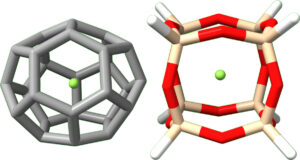2025 vol 4 issue 2
Full paper
Mar Ríos-Gutiérrez 1, Bartłomiej Gostyński 2 *
1 Department of Organic Chemistry, University of Valencia, Dr. Moliner 50, Burjassot, 46100 Valencia, Spain
2 Centre of Molecular and Macromolecular Studies Polish Academy of Sciences, ul. Sienkiewicza 112, 91-363 Łódź, Poland
* Correspondence to: bartlomiej.gostynski@cbmm.lodz.pl
pp. 94-114
DOI: 10.58332/scirad2025v4i2a01
Abstract
 This study investigates the encapsulation of the F- anion within fullerene and silsesquioxane (POSS) cage frameworks, using both Intermolecular Quantum Analysis (IQA) and Quantum Theory of Atoms in Molecules (QTAIM) at the DFT level of theory to analyze the effects of the F- presence on cage stability, as well as the nature of its interactions with the given framework. A detailed understanding of the energetic and electronic consequences of F- encapsulation is necessary to inform future design strategies for molecular encapsulation and ion stabilization in these and similar cage systems. The results suggest that the interaction between F- and the cage highly depends on steric and electronic factors; encapsulation generally destabilizes the cage, although certain systems show stabilization due to favorable interatomic interactions, as indicated by IQA analysis. The ion itself is stabilized in most systems, with POSS showing a significantly stronger stabilization than fullerenes. QTAIM analysis at bond critical points (BCPs) and cage critical points (CCPs) highlights the nature of the interactions, with electrostatic forces and charge redistribution being the primary stabilizing factors. The overall balance and stability of the F–cage complexes seem to be governed by the delicate interplay between steric compression and electrostatic interactions.
This study investigates the encapsulation of the F- anion within fullerene and silsesquioxane (POSS) cage frameworks, using both Intermolecular Quantum Analysis (IQA) and Quantum Theory of Atoms in Molecules (QTAIM) at the DFT level of theory to analyze the effects of the F- presence on cage stability, as well as the nature of its interactions with the given framework. A detailed understanding of the energetic and electronic consequences of F- encapsulation is necessary to inform future design strategies for molecular encapsulation and ion stabilization in these and similar cage systems. The results suggest that the interaction between F- and the cage highly depends on steric and electronic factors; encapsulation generally destabilizes the cage, although certain systems show stabilization due to favorable interatomic interactions, as indicated by IQA analysis. The ion itself is stabilized in most systems, with POSS showing a significantly stronger stabilization than fullerenes. QTAIM analysis at bond critical points (BCPs) and cage critical points (CCPs) highlights the nature of the interactions, with electrostatic forces and charge redistribution being the primary stabilizing factors. The overall balance and stability of the F–cage complexes seem to be governed by the delicate interplay between steric compression and electrostatic interactions.
Keywords
DFT, IQA, QTAIM, Fluoride ion, Fullerenes, POSS, Interactions
First published: 10.06.2025
